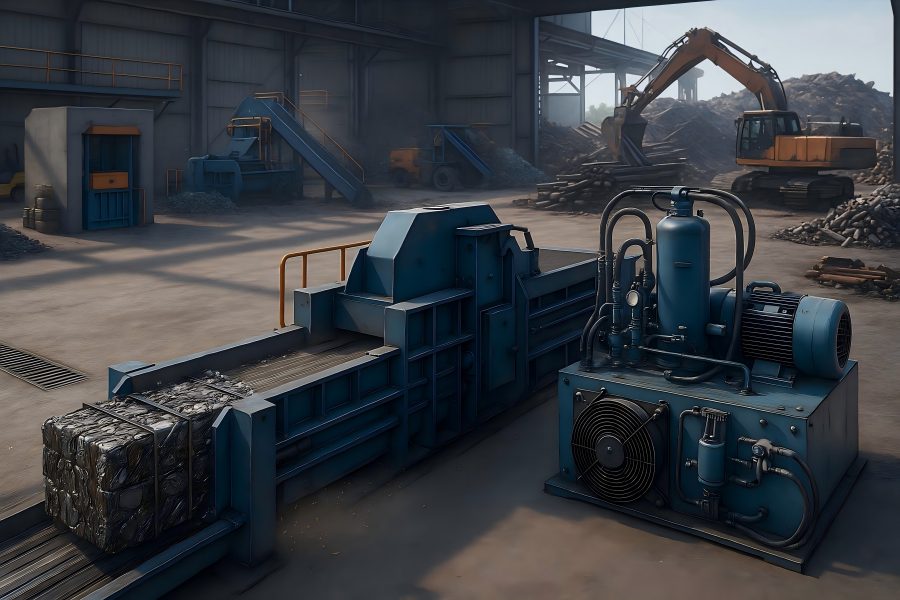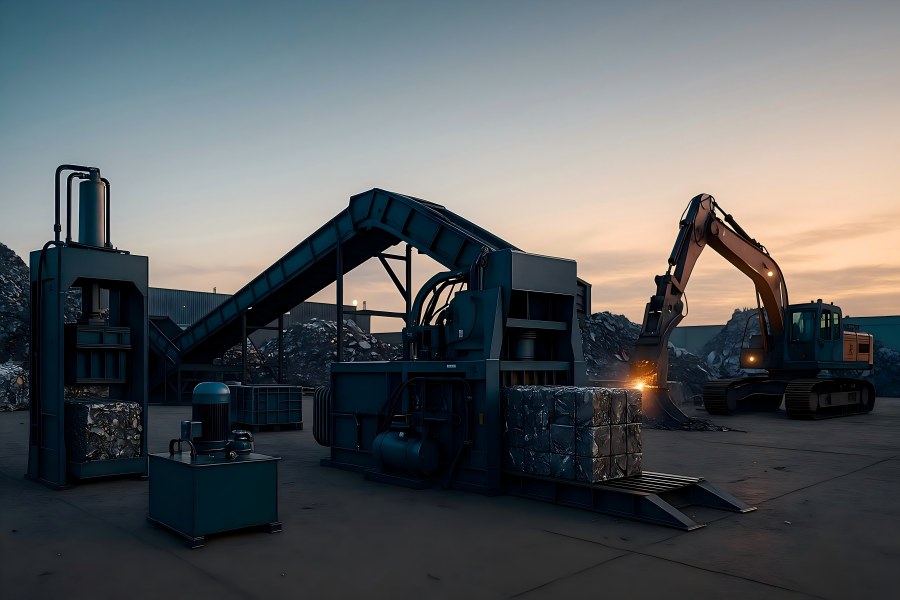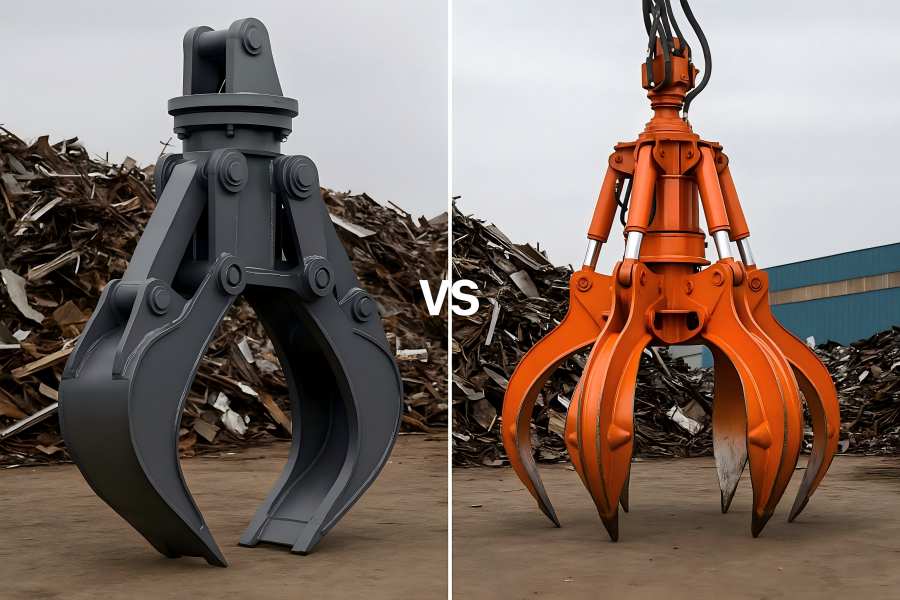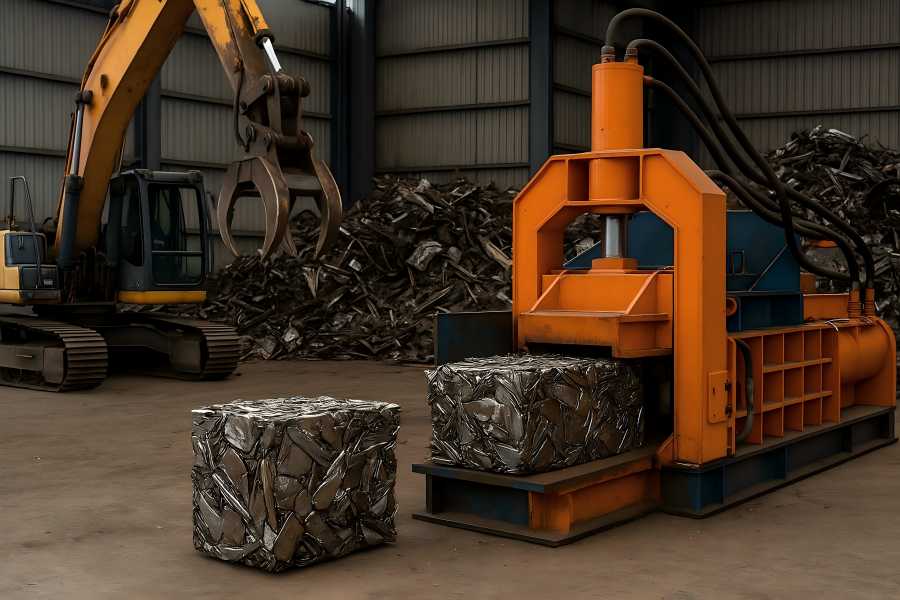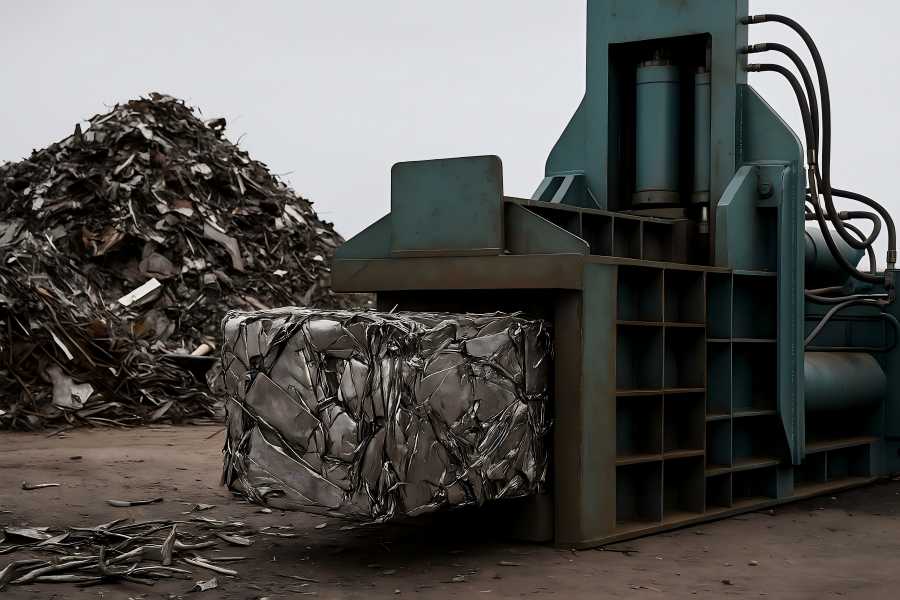Choosing a metal baler is ultimately a capacity and economics decision wrapped in safety, footprint, and downstream-quality constraints. The “best” machine for a small auto-dismantler would be a bottleneck for a regional shredder yard—and vice versa.
This guide gives you a scale-aware, step-by-step framework to match baler type and configuration to your volumes, material mix, staffing, space, and growth plans.
Start with four truths about balers and scale
Throughput must match inbound tonnage with cushion. If a yard takes in 60–80 tons per day but the metal baler can only process 3 tons per hour across a 6-hour baling window, you will build inventory and lose margin.
Bale quality must meet your buyer’s specifications. Mills and smelters care about density, size, contamination, and consistency. Different balers achieve different density and tie options.
Space, power, and labor are real constraints. A compact vertical baler can sit in a corner and run on modest power. A two-ram or shear/baler/logger (SBL) needs floor area, heavy electrical service (or diesel), and conveyor feed.
Hydraulics and controls determine cycle time, energy per ton, and uptime. You don’t have to be a hydraulic specialist, but you should know what you’re buying: fixed vs variable pumps, accumulator assist, regenerative circuits, and filtration/cooling strategy.
Define your scale in concrete terms
- Inbound volume (tons/day and tons/week): Break out ferrous vs nonferrous.
- Operating window (hours/day, shifts/week).
- Material mix: HMS, bushings, skeleton, white goods, turnings/borings, nonferrous clips (Al/Cu), stainless, radiators, cans, extrusions.
- Downstream requirement: Target bale size, tie method, minimum density, and contamination limits.
- Footprint and flow: Available floor area, ceiling height, feed method (conveyor, grapple, manual), ejection space, and truck dock constraints.
- Utilities and mobility: Available power (kVA), compressed air, cooling water; stationary vs mobile need.
- Staffing: How many operators per shift? Skill level for maintenance and controls.
Scale-to-solution map
Use the table below to narrow your starting point. Values are indicative and depend on scrap mix and site constraints.
| Business scale | Typical inbound (t/day) | Main materials | Recommended baler | Practical throughput target (t/h baled) | Typical bale form | Staffing (operators) |
| Micro shop / dismantler | 2–10 | Light ferrous, Al sheet/clips, radiators | Vertical or compact horizontal | 0.5–1.5 | 600×600 mm cubes; straps/wires | 1 |
| Small yard | 10–40 | Mixed light ferrous, white goods, Al cans/extrusions | Horizontal single-ram (with conveyor) | 1–3 | 800×800 mm; wires | 1–2 |
| Medium yard / small MRF | 40–120 | Mixed grades, nonferrous clips, some heavy | Two-ram horizontal | 3–8 | 800–1100 mm; wires/straps | 2 |
| Heavy ferrous yard | 80–250 | HMS, plate/structural, rebar, oversize | Shear/Baler/Logger (stationary or mobile) | 6–15 (material-dependent) | Dense logs/bales; shear cuts | 1–2 |
| High-volume MRF / regional | 150–400+ | Mixed streams, high uptime | High-power two-ram + conveyors + pre-sort | 8–20 | High-density, mill-spec bales | 2–3 |
| Machine shop cluster | 5–40 (chips) | Steel/Al turnings with coolant | Briquetter (+ bulk baler for skeleton) | 0.5–3 (pucks) | 60–120 mm pucks | 1 |
Calculate capacity: a simple worksheet
Metal balers live or die by cycle time and bale weight. Use this worksheet to see if an option clears your load with headroom.
Inputs
- Inbound volume: Vd tons/day
- Baling window: Hd hours/day actually baling (exclude breaks, changeovers)
- Bale mass: Mb tons/bale (depends on bale size and density)
- Cycle time: Tc minutes/bale (approach, crush, tie, eject)
- Cushion factor: C (1.2 to 1.5 to absorb surges)
Compute
- Bales/hour = 60 / Tc
- Throughput = (60 / Tc) × Mb tons/hour
- Required throughput = (Vd / Hd) × C
- Decision rule: Choose a baler whose real-world throughput ≥ Required throughput, with flexibility for your mix (nonferrous vs ferrous) and growth.
Worked example
A small yard receives 35 t/day, baling for 7 hours/day, and wants 25% cushion. Considering a horizontal single-ram that makes 0.5-ton bales in 12 minutes:
- Bales/hour = 60/12 = 5
- Throughput = 5 × 0.5 = 2.5 t/h
- Required throughput = (35/7) × 1.25 = 6.25 t/h
Result: the single-ram would be a bottleneck; you need a higher-output single-ram with faster cycle/denser bales, or more likely a two-ram or SBL, depending on material.
Matching baler type to your material reality
Light ferrous and white goods (low contamination)
Horizontal single-ram balers excel with steady conveyor feed. Choose a larger compression box and prepress if mattresses/appliances enter the stream. Wire tying is usually fine.
Mixed nonferrous (Al extrusion, UBC, clips, radiators)
A two-ram gives better density control, cleaner bale edges, and flexible tying. For UBC, bale size uniformity and strap integrity matter for downstream de-baling; ask vendors to prove bale integrity after drop tests.
Heavy ferrous (HMS, plate/structural, long stock)
SBLs shear and compact, solving upstream cutting and transport in one machine. If you routinely handle beams and pipe, prioritize shear force and box design (wing/side squeeze) and confirm cycle time under full shear loads, not just baling mode.
Turnings and borings
Add a briquetter for chips; improving density and recovering coolant can swing the ROI by itself. Keep a bulk baler for skeleton and offcuts.
Hydraulic power and control
- Load-sensing variable-displacement pumps (or VSD-driven pumps) to reduce heat and energy per ton.
- Accumulator assist for fast approach and shear events without oversizing motors.
- Regenerative circuits used intelligently only during low-load approach; cut out for high-force squeeze.
- Robust filtration and cooling: target ISO 4406 cleanliness in the high teens or better; keep oil 40–60 °C.
- Closed-loop pressure/position control for consistent density and shorter, smoother cycles.
- Instrumented manifolds with test ports, pressure transducers, and thermal sensors for diagnostics.
Ask vendors for energy per ton data under your scrap mix, not just nameplate kW.
Footprint, installation, and utilities
Space: Two-ram and SBL systems need straight runs for conveyors, bale ejection, wire units, and service clearances. Mock up the flow on your floor plan; don’t forget forklift paths and truck docks.
Foundations: Heavy machines often need reinforced pads. Verify anchor layout and loading.
Power: Check available kVA, voltage, and harmonics limits; two-ram/SBL can require 100–400+ kW connected load unless diesel-driven. Consider soft-start/VSD to ease inrush.
Noise and neighbors: Pumps and fans carry; plan enclosures or isolation if near offices or residential boundaries.
Dust and fire risk: Provide spark detection, suppression around conveyors, and clean-out access. For foundry/torch areas, discuss fire-resistant fluids and enclosure class with the vendor.
Staffing and safety
- Operators: Vertical and compact horizontal balers can be truly one-person operations. Two-ram and SBL lines typically use two operators (feed + baler) when running hard.
- Training: Plan vendor-led training for hydraulic safety, lockout/tagout, bale tying, and routine checks.
- Safety systems: E-stops, interlocked doors/lids, light curtains where appropriate, and rated hoses/fittings. Confirm compliance with your local standards and require documented risk assessment.
Total cost of ownership (TCO) beats sticker price
Capex is only part of the story. Model:
- Energy per ton (kWh/t or diesel liters/t).
- Wear parts: shear blades (SBL), tie wire/strap, filters, seals.
- Hydraulic oil and coolant service intervals.
- Unplanned downtime cost (missed loads, overtime sorting/storage).
- Wire/strap cost vs bale integrity. More ties can be cheaper than rejected loads.
Ask for a five-year TCO including recommended spares and scheduled maintenance. In many yards, a more expensive machine with 20–40% lower energy per ton and higher availability beats the cheaper option within two seasons.
Vendor evaluation and acceptance testing
Prove it on your material. A factory demo on clean clips isn’t proof for tangled HMS. Ship sample loads or negotiate a field trial.
- Witness KPI test: Measure cycle time, bale mass and size variance, energy per ton, and wire usage for at least four hours of continuous operation.
- Service network: Response time, local parts stock, and technician count matter. Ask for MTTR/MTBF data and references from similar-scale customers.
- Documentation: Electrical/hydraulic schematics, component lists (pump/valve brands), recommended spares, and maintenance schedule should be part of the bid—up front.
Red flags that often show up later as downtime
Undersized cooling and vague filtration specs. Hot, dirty oil kills pumps and valves. If the proposal skimps here, walk away.
No accumulator strategy, but aggressive cycle claims. A fast approach without the kW to back it up is marketing math.
Hard-to-service manifolds and filters buried under guards. If you can’t reach it, you won’t maintain it.
One-speed control logic. Lack of closed-loop pressure/position control means density and cycle time wander with the scrap mix.
Choosing by scale: practical recommendations
Micro shop/dismantler (2–10 t/day)
Pick a vertical baler or compact horizontal baler with manual feed. Prioritize safety interlocks, easy tying, and low noise. If nonferrous is a revenue focus, consider a compact two-ram only if your buyer pays for density and you can keep it fed.
Small yard (10–40 t/day)
A horizontal single-ram with conveyor feed is often the sweet spot. Look for load-sensing hydraulics, an accumulator-assisted approach, and a decent box size. If your mix includes significant nonferrous clips and you sell to mills with strict bale specs, price a small two-ram as well.
Medium yard / high-mix (40–120 t/day)
Go two-ram. You’ll get better bale quality across grades and higher sustained throughput. Insist on proven controls (pressure and position loops), wire system reliability, and robust cooling.
Heavy ferrous yard (80–250 t/day) or oversize input
Choose an SBL. Size it for the longest and thickest material you routinely see, not just average loads. Validate shear force, box squeeze, and per-log cycle times with your stock.
Regional high-volume (150–400+ t/day)
A high-power two-ram integrated with infeed conveyors, pre-sort, and dust control is the backbone. Consider redundancy (two units or one plus a smaller backup) to protect shipping commitments.
Machine shops (chips/turnings)
Add a briquetter for turnings (steel and aluminum) to raise density, recover coolant, and reduce hauling. Keep a bulk baler for skeleton, drops, and crating.

